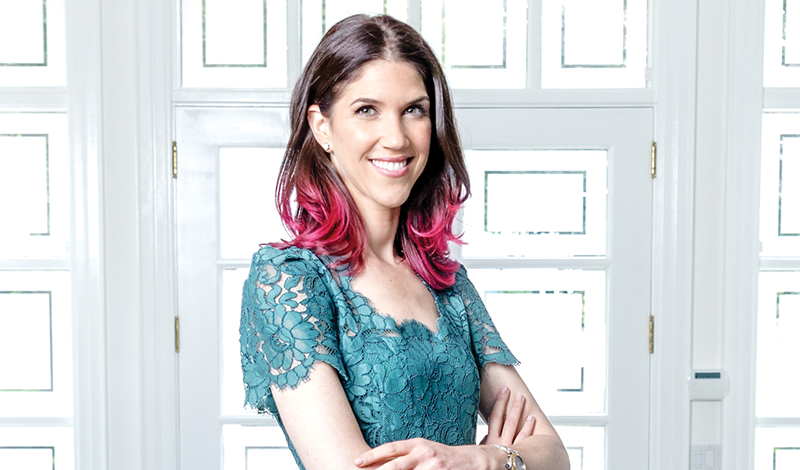Breathing Life Into a Room Through Art – Jessica Herzig
Jessica Herzig, principal of Jessica Herzig Art Advisory, has been in the art industry for over a decade. And she’s loved every second of it.
Jessica Herzig is not your run-of-the-mill art curator. The bubbly 30-something has been paving her way in an industry that isn’t quite known to lend itself to young, ambitious entrepreneurs like herself. Herzig is a lively, out-of-the-box visionary with an acute taste for the finer things and a deep appreciation for contemporary art and unique collections. As a young girl, Herzig was exposed to “the greats” by way of colouring books and frequent visits to international museums and gallery exhibits, where she was totally captivated by the shapes and colours that surrounded her.
After spending five years in the United States working at Sotheby’s New York headquarters, the curator returned home to Toronto and, soon after in 2013, began Jessica Herzig Art Advisory (JHAA), a full-service consultancy firm that works with corporate and private clients on developing both emerging and blue-chip curatorial collections, as well as rotating art exhibitions across the globe. Whether it’s helping a young professional start their very first collection or helping a seasoned collector hunt for the perfect addition to theirs, Herzig has an eye for perfection and takes on each new job with the same passion and vigour as the last.
When were you first exposed to the art world? Was this a path you were always drawn to?
As a child, I was given a colouring book of famous paintings, which had a black-and-white version of each painting on the right-hand page and information on the artist and artwork on the left. I loved it and pored over every word. When we would travel, my parents took me to museums, and I began to recognize the artworks. Working in a museum became my dream, and that was my first job in the art world.
I read that early on you were captivated by the Italian painter Caravaggio. What is it about his baroque style that caught your eye?
Everything about Caravaggio’s work got my pulse racing; the dramatic lighting, the composition and the subject matter felt provocative and intensely emotional. It was an early lesson on the transcendent impact that great art can have. My favourite thing to do in Rome is to visit San Luigi dei Francesi and feed coins into the automated box that illuminates his paintings from the darkness.
How have your tastes evolved since you first began your studies?
In school at Emory I studied art history and worked at the Michael C. Carlos Museum, which focuses on ancient art. After I finished my undergrad I started immersing myself in the contemporary art world. I still appreciate the historical, but I also enjoy meeting up-and-coming artists.
Since making the shift from Sotheby’s, what have you gained by turning your passion into entrepreneurship and establishing your own company?
Sotheby’s was an amazing training ground; I was working with some of the most important and valuable artworks in the world, across numerous collecting categories. But corporate culture comes with a lot of red tape, and I craved the flexibility and creativity that building my own business could offer.
What are some lessons from your past experiences that have helped you grow your business?
I’ve learned that expertise is vital, but it must be coupled with superb client service. I’m working with a luxury commodity, and people want a detail-oriented, seamless experience. It’s also important to keep a sense of levity and fun in the process, too.
What were some of the initial obstacles you faced in establishing JHAA?
There were times I longed for an instruction manual on how to navigate art tax law or customs brokerage — the nuts and bolts of the business. Amalgamating that knowledge through experience was a challenge, but a rewarding one.
“I’m not much of a stickler for rules in collecting — being idiosyncratic in your choices is the key to creating a collection that is interesting and personal”
What about the curation process do you enjoy most?
I enjoy the whole process, but once the right pieces have been found, installation is great fun. It’s incredible how much life art can breathe into a room.
What is a common misconception about what you do?
That an art advisor is only for major collectors buying blue-chip pieces. I work with young people on their very first purchases as well. Having guidance on where to look and the right questions to ask is helpful for any acquisition, big or small.
As a private curator, you must be a people person. How do you establish successful relationships with clients? And what kind of questions do you ask to help you gauge their taste?
When I first meet a client, I visit them at home. I take a look at the artwork they already have, if any. We speak in depth about their interests, lifestyle, work and family life. For corporate clients, I go to the office space and learn about the company, its culture and its goals.
Some clients give me carte blanche to create an environment on their behalf, whereas others want to be much more involved in the process.
I encourage clients to send me images of things that inspire them — I’ll receive photos of landscapes from a vacation, a beautiful textile on a coat, graffiti on the street. That can help me create a visual vocabulary and tailor artworks to their taste, and also [gives me] a jumping-off point to push the envelope a little further.
What are your relationships with artists like? We imagine that you encounter captivating, unique personalities daily.
Seeing completed work in an exhibition setting is great, but it’s such a creative charge meeting the artists and learning about their motivations, influences and practice. On studio visits, you can see the images and books they are studying, hear the music they are listening to. Is it totally chaotic or meticulously neat, solitary or bustling with assistants? It’s all informative to me, and all fascinating.
What are your thoughts on the business of art and social media?
I find Instagram can be a very useful tool to follow galleries and artists around the world; it’s a great way to discover new work and share what’s inspiring me on @artadvisory.
What’s a typical day in the life of an art curator?
It can consist of meeting a client at a gallery to see a show, touring an artist’s studio, dropping by the framer to check how a piece turned out, and overseeing an installation at a residence or office. Every day is different, which is amazing.
What’s the key to a beautiful and tasteful collection? Are there rules?
I’m not much of a stickler for rules in collecting — being idiosyncratic in your choices is the key to creating a collection that is interesting and personal.
I am particular about how art is installed, though. How works are framed and hung can make a world of difference in terms of tastefulness and stability from a conservation point of view. So my “rules” are more technical — I won’t hang a photograph or work on paper by a window where direct sunlight will fade it, for example.
How did your time in the United States influence your career and perspective?
The scale and velocity of the American art market is on another level. My work experience there was immensely valuable in terms of the network of contacts I acquired, and I go back often for art fairs and auctions. But after living in the U.S. for almost 15 years, I love how comparatively low-key Canada is.
Where have you travelled? Which place has provided the most inspiration?
Paris is my favourite city for museums. New York is my favourite for galleries. And for overall inspirational vibe, Tel Aviv’s art scene is very exciting.
Can you describe your personal collection?
My husband and I love to collect together and focus mostly on work by artists who are young and Canada-based, like us. Toronto has incredible talent and it makes sense to us to explore and support that.
What is it about our local art scene here in Toronto that puts us on the map? Is there more we could do to promote and support emerging artists?
There is a tendency in Toronto to look over our city’s shoulder, so to speak, to artists and galleries beyond our borders for an international stamp of approval. But there is a lot to be said for the calibre of work here. Toronto is remarkably diverse, attracting artists from all over Canada and the world. We have a number of art fairs throughout the year, and significant galleries with brave programming. I feel exceptionally fortunate to live and work here.
photos by robin gartner
















































































No Comment